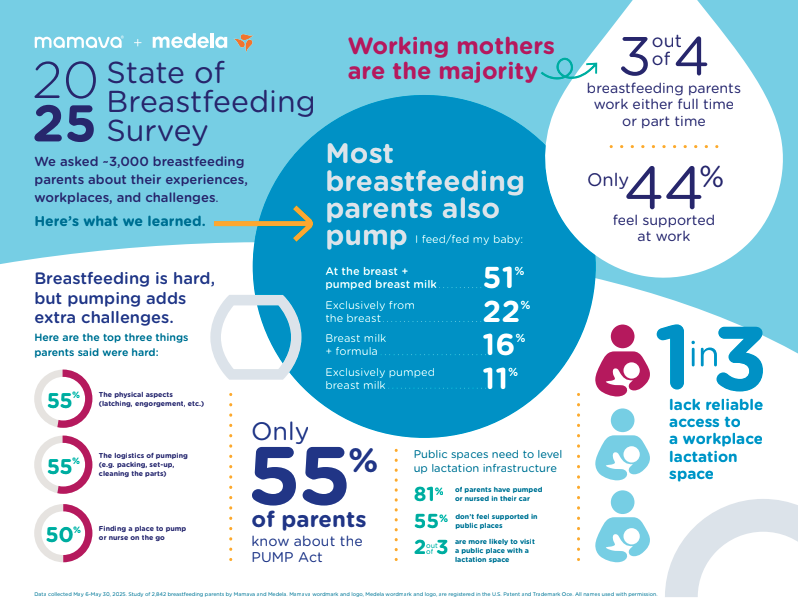The 2025 State of Breastfeeding Survey
Mamava and Medela surveyed almost 3,000 breastfeeding parents in May of 2025 to learn more about their feeding journeys, challenges, and support systems. The findings, for the third year in a row, highlight the fact that pumping is a key part of breastfeeding for most parents and that both workplaces and public spaces need to improve lactation infrastructure. “Breastfeeding looks different for different parents, but one thing we know for certain is that support for breastfeeding—in workplaces and in public—is not meeting the needs of today’s parents,” said Mamava Cofounder Sascha Mayer.
Parents are motivated by the health benefits of breastfeeding
Almost 90% of respondents cited the health benefits—for baby and mother—as a primary motivation to breastfeed, followed closely by the ability to nourish their babies (84%) with their own milk, and bond with their baby (75%). While 16% of respondents combo feed (breast milk and formula), 45% of respondents reported that they breastfed because they did not want to rely on formula.
Meeting the recommended breastfeeding guidelines is not easy
Two out of three respondents (66%) were able to meet the recommendations to exclusively breastfeed for the first six months, which is significantly higher than the national average of 25%. This survey was distributed by two well-known breastfeeding brands, so the audience is especially enthusiastic and interested in breastfeeding. Yet despite the updated recommendations to breastfeed up to two years when possible, only half of respondents (54%) were still breastfeeding at one year and with just 16% making it to two years. The findings suggest that many parents are finding it difficult to meet the updated recommendations of the American Academy of Pediatrics and the World Health Organization.
Pumping is one of the biggest breastfeeding challenges
Of the top three challenges identified by respondents, two out of three were about pumping: 1) The logistics of pumping equipment; 2) The physical aspects of breastfeeding itself (latching, etc.); 3) Finding a place to pump or nurse on the go. This finding reinforces the importance of providing lactation spaces—in workspaces and public places—as well as the value of additional amenities such as a hospital-grade pump, cleaning supplies, and personal storage for pump parts and breast milk at work. There is a tremendous opportunity for employers to help reduce two of the top breastfeeding challenges for working parents.
Most breastfeeding mothers work, but workplaces still don’t work for mothers
The majority of survey respondents (76%) work either full time or part time, but only 44% feel supported at work and 1 out of 3 lack reliable access to a lactation space. Notably, only 55% of respondents understand their legal protections under the PUMP for Nursing Mothers Act—the 2022 federal labor law that mandates workplace lactation accommodations. These findings suggest that employers need to improve not only their workplace lactation support, but also their efforts to educate breastfeeding employees about their workplace rights.
Public spaces need more lactation support infrastructure
More than half (55%) of survey respondents don’t feel supported in public places like stadiums, zoos, stores, etc. In fact 81% report that they have pumped or nursed in their car. The findings indicate that public places have a long way to go when it comes to providing the kind of support breastfeeding parents need. Yet 2 out of 3 respondents are more likely to visit a public place with a lactation space—which suggests that supporting parents is mutually beneficial for both families and public places.
Breastfeeding parents rely on lactation consultants and the internet for information
When asked where they go for breastfeeding information and support, lactation consultants were at the top of the list at 63%— followed by internet searches at 61% and friends and family at 57%. The findings suggest that having access to lactation consultants is a huge benefit for new breastfeeding parents, but also reinforces the value of community and easy access to accurate, evidence-based online resources.
Survey methodology
The 2025 State of Breastfeeding Survey was fielded by Mamava and Medela over three weeks in May of 2025. Respondents were U.S. parents who are currently nursing or have breastfed within the last two years, totaling 2,842 responses.
For media inquiries contact: [email protected]
Mamava designs solutions to empower breastfeeding and pumping parents on the go, like our freestanding lactation pods, Mamava’s lactation space locator app, and other helpful resources.








